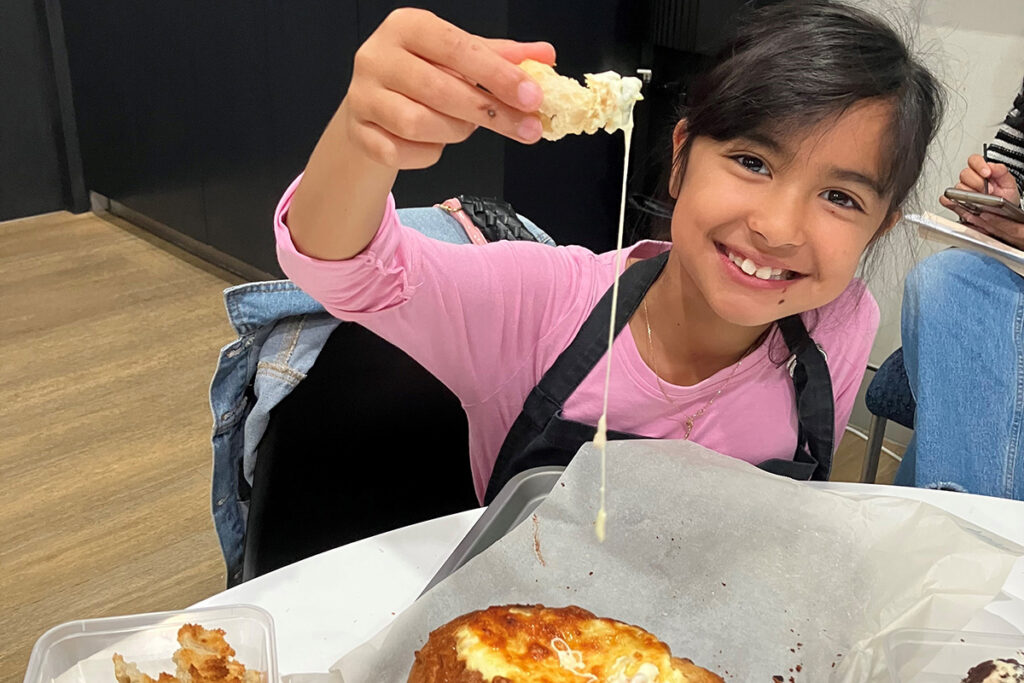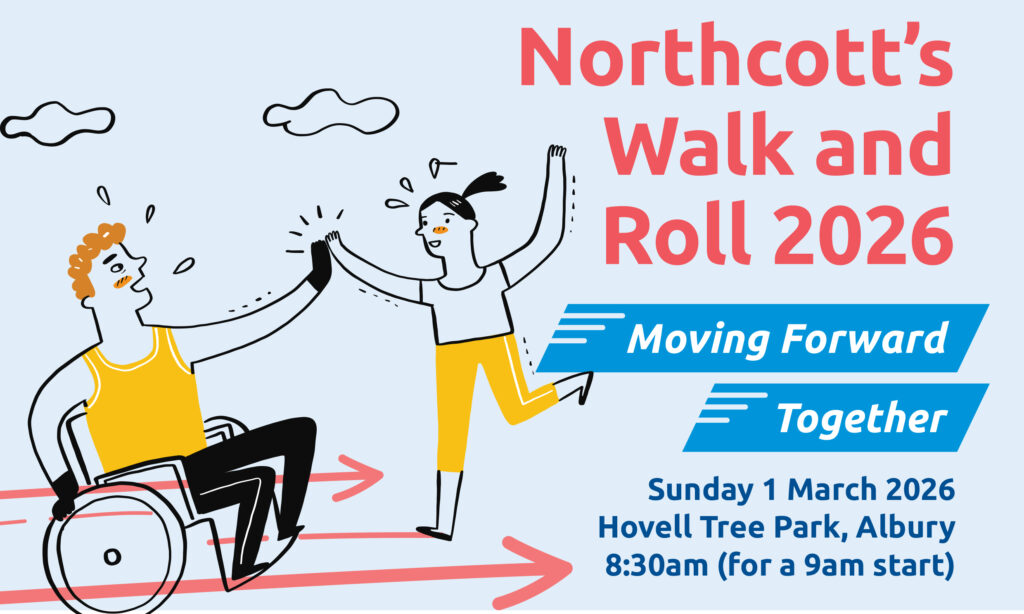
April is World Autism Month. To continue our journey on generating awareness about Autism Spectrum Disorder (ASD), we share Northcott Diversity and Inclusion Specialist, Ashlee’s neuro-spicy journey written in her own words.
**Quick note** Don’t expect me to mirror Greta Thunberg, Sheldon Cooper, or Dustin Hoffman’s character in Rain Man—you’ll be sorely disappointed.
In 2019, at the age of 30, I experienced one of the absolute highlights of my life: my autism revelation. It was like someone had decoded my entire existence, turning on a light in a room that had always felt dim. Suddenly, everything made sense, and the feeling was exhilarating. After a lifetime of feeling ‘wrong’, different, out of place and as if I was always missing that ‘something’ that seemed so obvious to others, my diagnosis finally made sense of everything up to that point. I felt like I had just discovered the real me.
Fast forward five years, and here I stand: a “neuro-spicy” woman, championing invisible disabilities and neurodiversity in all corners of my life. I’m a mum to three amazing autistic/ADHD kids and partnered with an extraordinary (albeit ‘neuro-typical’) bloke who brings a touch of the unconventional to our clan.
It’s well acknowledged in the ASD community – meet one person with autism, and you’ve met just that—one person. Each of us charts a distinct path, with unique experiences and hurdles. It was through my children’s diagnostic journeys that I found the breadcrumbs leading to my own neurodiverse self. My hope is that in sharing my story, I’ll cast some light on the autistic experience and inspire others to open up about theirs.
I was always the social butterfly, creative and mostly cheerful, yet tagged as ‘overly emotional’ and a ‘daydreamer’. While I had made many close friends, developing friendships and socialising didn’t come naturally. But I was a champ at blending in—unintentionally “masking” my true self. My life was a patchwork of misdiagnoses and ill-fitting labels. Like many women with autism, I slid under the radar, my experiences didn’t align with the conventional criteria, leading to a delayed recognition of my ASD.
Even post-diagnosis, there’s been a fair share of head-scratching. I’ve lost count of how many times I’ve been hit with “You don’t look autistic?” or “But you’re so high functioning!” or my personal kryptonite “Aren’t we all a little bit Autistic?” These comments, though often well-intentioned, do hurt, and are tinged with misunderstanding—a product of the same lack of awareness I once faced. It’s an opening for me to educate and advocate for a better understanding of autism, particularly in women. For the sake of all the neurodiverse individuals out there, let’s set the record straight on one of the common misconceptions people still ask me about: we aren’t all coders or human calculators! I’m absolutely TERRIBLE at math. My brain isn’t a supercomputer, and I’m not a genius. It’s time to get rid of these and other myths surrounding autistic individuals once and for all.
Despite the strides we’ve made, women like me remain on the outskirts of autism representation. To bridge this gap, I’ll unpack the Diagnostic and Statistical Manual of Mental Disorders, Fifth Edition’s (DSM-5) autism criteria and walk you through how I express these in daily life. Just a heads-up, this is purely my story—another person with the same label might walk an entirely different path. And while I say, ‘autistic person’—as autism is a fundamental part of who I am—others may prefer ‘person with autism’. Always check in with an individual on how they’d like to be described, and remember, it’s not our place to police their preference.
What is the definition of autism as per DSM-5?
The DSM-5 outlines that one must show “persistent deficits in each three areas of social communication and interaction, plus at least two of four types of restricted, repetitive behaviours.”
Let’s explore these “persistent deficits” in social communication and interaction that I navigate:
- Deficits in social-emotional exchanges:
Ever been on a call, clueless about whose turn it is to talk or when to wrap things up? —that’s my daily struggle. And empathy? Though commonly believed otherwise, we feel it deeply. So much so, it can be paralysing, making even fictional characters’ embarrassments in a movie scene too intense to bear. I’m so attuned to others’ feelings that it can be overwhelming. - Deficits in nonverbal communicative behaviour used for social interactions:
I’m often told that my body language can be misleading—avoidant glances, restless movements, expressions that don’t match my mood—actions I’m completely oblivious to in the moment. - Deficits in developing, maintaining and understanding relationships:
I can definitely relate here! I have always had difficulty adjusting myself to suit various social situations. If I had a dollar for every time I’ve made a joke at the wrong time or place, I’d be a millionaire! I can maintain relationships with people, and most my friendships are well over a decade long. Loyalty and honesty are my strong suit, (though I can be a bit too honest for social expectations at times), but I do find it hard to bear when this isn’t returned by others. Once trust is broken with me, I find it almost impossible to get back.
Now, onto the “restricted, repetitive patterns of behaviour, interests, or activities”, as I experience them.
- Stereotyped or repetitive motor movements, use of objects, or speech:
The stereotypical “repetitive motor movements” or “stims “people usually think of are spinning or hand-flapping, but those of us who weren’t diagnosed until adulthood because we learned how to mask many of our symptoms tend to have smaller or less-noticeable stims. my quirks are subtler, like constantly fiddling with my fingernails, or ring-twirling—a lifelong, unconscious self-soothing behaviour. - Insistence of sameness, inflexible adherence to routines or ritualised patterns or verbal nonverbal behaviour:
Sudden changes can throw me for a loop. I’m the planner extraordinaire, considering all possible outcomes. A spontaneous “let’s see where the wind takes us” holiday? No, thanks, that’s the stuff of my nightmares! - Highly restricted, fixated interests that are abnormal in intensity or focus:
I often find myself caught up by one obsession or another. Whether it’s losing myself in e-books on my Kindle, getting creative with painting or sketching, or diving into any other interest, there’s always one thing that grabs my attention and won’t let it go, making it hard to focus on anything else. The interests might not be out of the ordinary, but my dedication to them. That’s on a whole other level. Unlike most people who can switch gears when needed, my brain digs its heels in and refuses to let go of whatever has me hooked at the moment.
Whatever I do, I attack it with 110% and am somewhat of a perfectionist. For me, there is no such thing as a quick project or a brief outline, even when I want to, and I often find myself going down rabbit holes and getting caught up in details. Creativity fuels me, and when something grabs my interest, I can’t help but hyperfocus on it. While hyperfocus has its perks, it can also be a tricky beast to tame. During hyperfocus moments (like right now as I write this!), basic needs often slip my mind, and I won’t hear or be aware of what’s happening around me. Changing tasks before finishing them leaves me feeling frustrated and drained. - Hyper- or Hypo-reactivity to sensory input or unusual interests in sensory aspects of the environment:
This one is a mixed bag, really. High pain tolerance? Check. Sensory overload in the supermarket? Also check. I’ve got a ridiculously high pain tolerance. More than once, I’ve broken bones without even realising it until days later – this tends to unsettle those around me, but I like to think of it as essentially being a superhero, which is awesome. There are certainly challenges to sensory input though. For example, I am so distracted by various sensory input that simple things can become difficult for me. Ever see someone get lost in a parking lot because they can’t figure out the signs? That’s me. I’ve become quite famous among my friends and colleagues for getting ridiculously lost or misdirected on numerous occasions, much to their ongoing amusement.
Wrapping this up, I hope you’ve gotten a glimpse into my world and see that autism, especially in adults and women, isn’t a one-size-fits-all. Each person on the spectrum experiences life uniquely, and understanding this diversity is crucial. On World Autism Month, let’s recognise that neurodiversity is intrinsic to who we are—no cures or boxes needed. Each of us, “neuro-spicy” or not, is uniquely ourselves, and that’s worth celebrating.



Accessibility and Inclusivity
We respect and honour Aboriginal and Torres Strait Islander Elders past, present and future. We acknowledge the stories, traditions and living cultures of Aboriginal and Torres Strait Islander peoples on this land and commit to building a brighter future together.
Read more about our commitment to reconciliation

